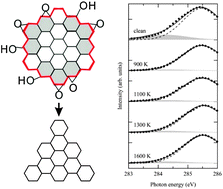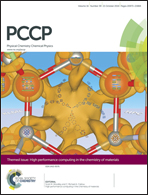Preferential oxidation-induced etching of zigzag edges in nanographene
Abstract
We investigated the thermal oxidation process of nanographene using activated carbon fibers (ACFs) by thermogravimetry (TG), X-ray photoemission spectroscopy (XPS), near-edge X-ray absorption fine structure (NEXAFS), and electrical conductance measurements. The oxidation process started from the edge of nanographene with the formation of phenol (–OH) or ether (C–O–C) groups attached to edge carbon atoms, as verified by the XPS and NEXAFS results. While the TG results indicated a decrease in the size of the nanographene sheet during the oxidation process, the intensity of the edge-state peak, i.e., the signature of the zigzag edge, decreased in the C K-edge NEXAFS spectra. This suggests that the zigzag edge preferentially reacted with oxygen and that the nanographene terminated with the thermodynamically unstable zigzag edges converted to one terminated with stable armchair edges. As the oxidation temperature increased, the activation energy for the electron hopping transport governed by the Coulomb gap variable range hopping between the nanographene sheets increased, and the tunneling barrier decreased. This change can be understood on the basis of the decrease in the size of the nanographene sheets together with the preferential etching of nanographene edges and the decrease in the inter-nanographene-sheet distance.


 Please wait while we load your content...
Please wait while we load your content...